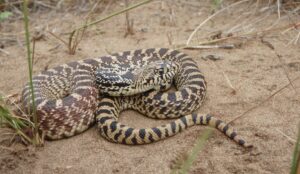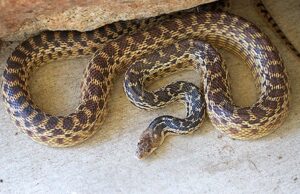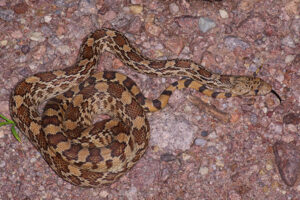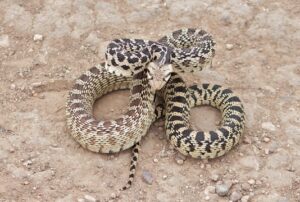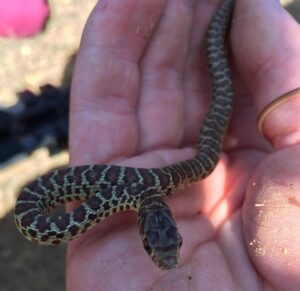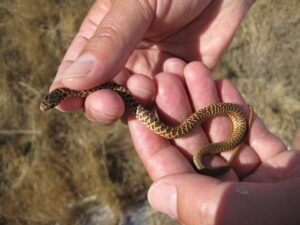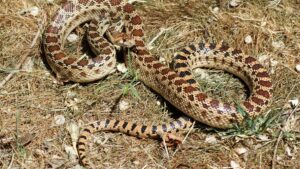The gopher snake is a heavy-bodied, large colubrid native to North America. The specific name catenifer means “chain-bearing” in Latin, referring to the snake’s dorsal color pattern. They are primarily active during the day but are active after sundown on hot days. It is the commonest serpent of its endemic continent. The solitary snake is hugely territorial and excellent at burrowing and climbing.
Scientific Classifications
- Suborder:Serpentes
- Family:Colubridae
- Genus:Pituophis
- Species:P. catenifer
Conservation Status
Subspecies
This snake has seven recognized subspecies.
- Sonoran gopher snake (Pituophis catenifer affinis)
- San Diego gopher snake (Pituophis catenifer annectens)
- Pacific gopher snake (Pituophis catenifer catenifer)
- Great Basin gopher snake (Pituophis catenifer deserticola)
- San Martin Island gopher snake (Pituophis catenifer fulginatus)
- Santa Cruz Island gopher snake (Pituophis catenifer pumilis)
- Bullsnake (Pituophis catenifer sayi)
Description
Size
A full-sized adult snake of this species measures 36-84 in (91-213 cm) in length. The largest gopher snake recorded had a length of 102 in (260 cm).
Color and Appearance
Dorsally, the gopher snake is pale brown or yellowish, having a series of big black or dark brown blotches with smaller dark spots at the sides. The belly is yellowish – either uniformly or with brown patterns. An identifying trait is the shape of its tail which always ends in a point.
Are They Dangerous to Humans
The colubrid has a unique defense mechanism. It puffs up its body and curls itself to resemble the classic striking pose of a rattlesnake. But instead of an open-mouthed strike like the latter, the gopher snake strikes with a closed mouth, using its blunt nose to warn its attacker. It also vibrates its tail producing a sound similar to rattlesnakes (despite having no rattle), and hisses loudly. Though the colubrid lacks poison or fangs, its bite can be very painful as it clamps down hard on the skin. But it bites only when harassed, as a last resort.
The bite requires proper wound care treatment that is best done by a medical professional. It should be cleaned with soap and water to prevent infection and warrants prompt medical attention in case of severe pain, swelling, allergic reactions, and other signs of infection.
One paper observed that gopher snakes in regions without rattlesnakes vibrate their tails for shorter periods than in areas with a substantial rattlesnake population. A possible reason could be that the predators in the former areas have not evolved to guard themselves again tail-vibrating snakes.
Gopher Snakes at a Glance
Distribution
The gopher snake occurs from southwestern Canada southward to northern New Mexico. It ranges from southern Alberta, Saskatchewan, and south-central British Columbia through western and central United States, and south through Sinaloa and Baja California, Zacatecas, Tamaulipas, and Durango states of Mexico. In the US, it is found from the Pacific Coast east to Illinois, Wisconsin, Missouri, western Texas, and Oklahoma.
Habitat
It inhabits a wide range of habitats, including deserts, woodlands, chaparral, prairies, shrublands, and agricultural areas (like cultivated fields). Studies have shown that though they often live near moist areas, like moist woodlands and marshes, they prefer spending most of their time in the open parts of these habitats, like forest edges and grasslands. Their preference is likely linked to their foraging activities.
They live under logs and rocks and in the burrows of other animals.
Lifespan
In the wild, the snake typically lives for as long as 12-15 years. The maximum lifespan recorded for a captive specimen is over 33 years.
Predators
Its most common predators are kit foxes, red-tailed hawks, and coyotes. But it is probably also eaten by other hawks, foxes, and big king snakes.
Diet
It eats birds, small mammals, smaller snakes, lizards, eggs, and insects, capturing and killing its prey by constriction. It is called the gopher snake as its diet exclusively consists of gophers in some areas. It is used for pest control by growers. The babies eat more insects and lizards than the full-grown ones.
Reproduction
Oviparous (lays eggs that hatch outside the body)
Males compete to mate with as many sexually receptive females as they can find. Females emit skin secretions that are detected by males stimulating mating behavior. The opposite sexes generally don’t associate before and after mating.
They breed once yearly, usually from June to August. Some females lay two clutches in a year, in nests that are sometimes communal. A clutch consists of 2-24 eggs with an incubation period of 65-75 days. After the eggs are laid, the female doesn’t care for the young. The males reach sexual maturity at 1.5 years, and the females at 4 years.
Similar Species
Rattlesnake
The head of a rattlesnake is broader. Plus, the gopher snake lacks the black and white bands on the tail, an identifying trait of rattlesnakes. Also, a gopher snake’s eyes have round pupils, while they are vertical in the case of rattlesnakes.
Bullsnake
The bullsnake (Pituophis catenifer sayi) is much larger as it can grow up to 8 ft (2.43 m). They are more aggressive than gopher snakes.
Garter Snake
Garter snakes have stripes on their bodies, while gopher snakes have blotches. Plus, the former are smaller, reaching a maximum length of around 54 in (137 cm).
Rat Snake
Gopher snakes usually have more geometric and smaller markings on their backs than rat snakes. The former’s scales are more heavily keeled than the latter. Gopher snakes have narrower and more pointed snoots for efficient digging.
Kingsnake
Kingsnakes have light-colored bands on a darker background color. They can be chocolate brown with cream bands or black with white bands.
The glossy snake (Arizona elegans) is smaller.
Care Sheet
The gopher snake is not aggressive. It is friendly and docile in its temperament and allows itself to be handled without any fuss. All these qualities make it a good pet.
Size of the Enclosure: The smaller adults can be housed in 30-gallon tanks or 41-quart tubs, while the bigger ones need tank sizes of 4 ft length. The hatchlings can be kept in 6-quart or 5-gallon tanks.
Temperature: The hot end should be maintained at 90°F and the cool end at 75°F.
Humidity: The pet needs low to moderate humidity levels below 60%. A water bowl spacious enough for the snake to submerge itself should be provided at the cool end of the tank.
Substrate: A thick layer of loose particle bedding works for the pet as it loves burrowing. Aspen bedding is the best substrate for the pet setup.
Feeding: Mice are the best food for these snakes. The juveniles can be fed defrosted pinky mice weekly, and the adults can be fed large frozen thawed mice once every two weeks.
FAQs
Ans. Yes, gopher snakes kill rattlesnakes as being in the same range they compete for food. Thus they help in keeping rattlesnakes away.
Ans. Though a gopher snake bite is not dangerous to your dog as it is non-venomous, it needs proper first aid and treatment to keep infections at bay. Additionally, the painful bite can hurt your faithful friend a lot.
Ans. No, they cannot.
Ans. Yes, they can.
Source
mnherps.com, desertusa.com, wildherps.com, dnr.state.mn.us, burkemuseum.org, reddit.com, flickr.com

